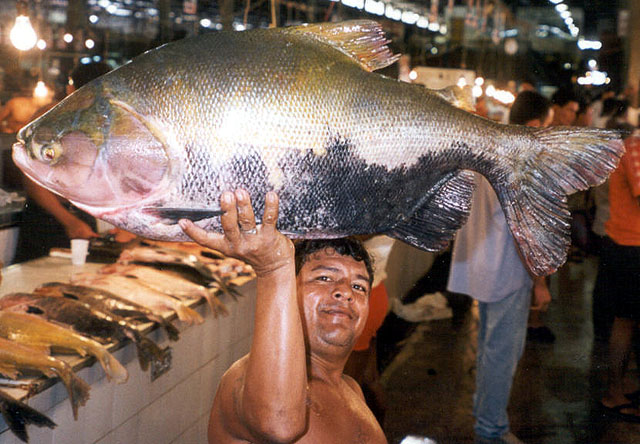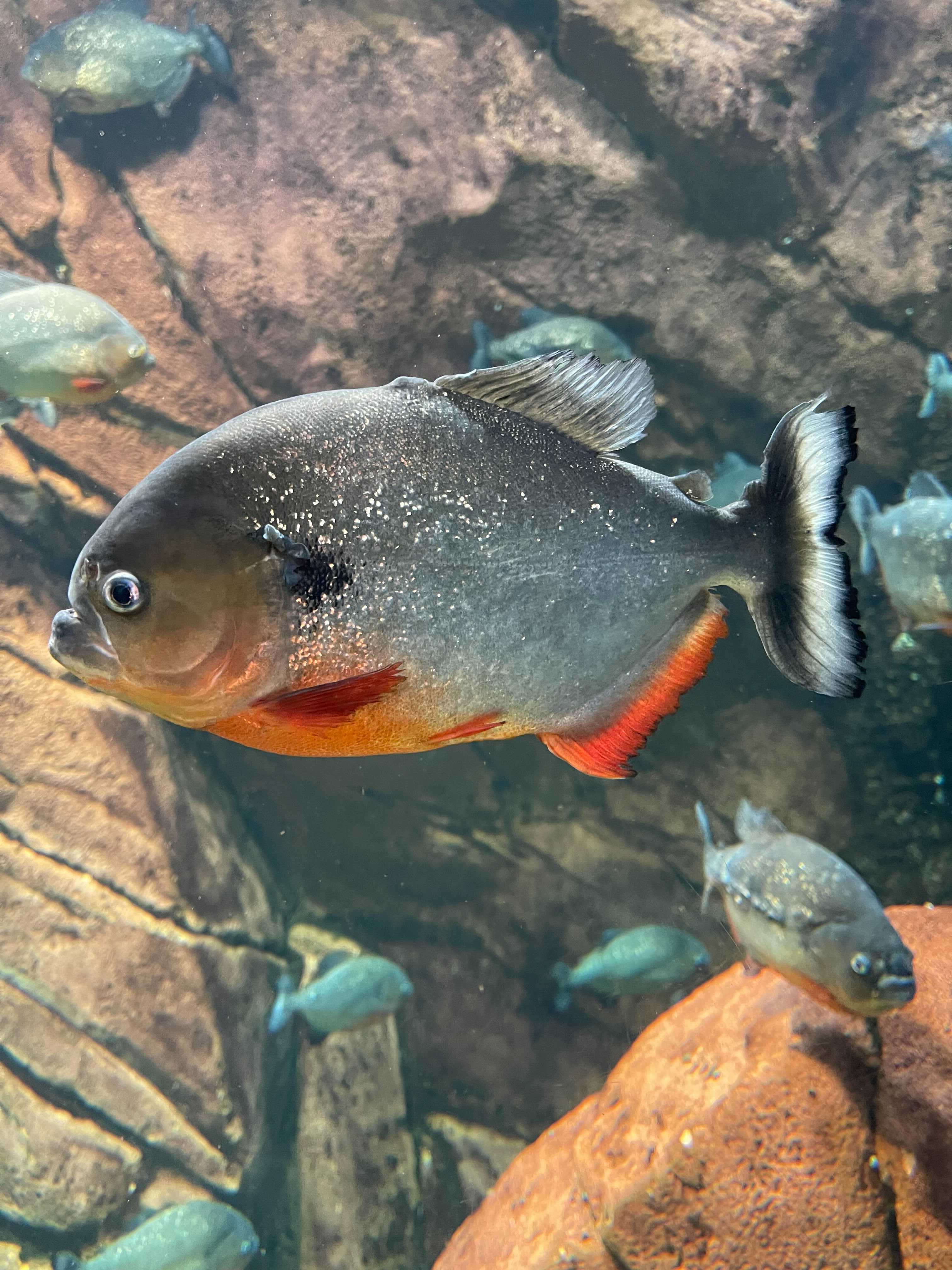|
Pacu
Pacu () is a common name used to refer to several species of omnivorous South American freshwater Serrasalmidae, serrasalmid fish related to piranhas. Pacu and piranha do not have similar teeth, the main difference being jaw alignment; piranha have pointed, razor-sharp teeth in a pronounced underbite, whereas pacu have squarer, straighter teeth and a less severe underbite, or a slight malocclusion, overbite. Pacu, unlike piranha, mainly feed on plant material and not flesh or Fish scale, scales. Additionally, the pacu can reach much larger sizes than piranha, at up to in total length and in weight. Name The common name ''pacu'' is generally applied to fish classified under the below listed Genus, genera. Among these, several genera contain species where commonly used English names include the word ''pacu'', as listed. *Subfamily Colossomatinae **''Colossoma'' – black pacu, black-finned pacu, giant pacu **''Mylossoma '' **''Piaractus'' – red-bellied pacu, small-scaled pacu ... [...More Info...] [...Related Items...] OR: [Wikipedia] [Google] [Baidu] |
Piaractus Brachypomus
''Piaractus brachypomus'' also known as the red-bellied Pacu or pirapitinga, is a large species of pacu, a close relative of piranhas and silver dollar (fish), silver dollars, in the serrasalmid family.Nico, L.; P. Fuller; and M. Neilson (22 October 2013)Piaractus brachypomus.USGS Nonindigenous Aquatic Species Database, Gainesville, FL. Retrieved 2 March 2017. It is native to the Amazon basin in tropical South America, but it formerly included populations in the Orinoco, which was described in 2019 as a separate species, ''Piaractus orinoquensis, P. orinoquensis''.Escobar, M.D., R.P. Ota, A. Machado-Allison, I.P. Farias and T. Hrbek (2019). A new species of ''Piaractus'' (Characiformes: Serrasalmidae) from the Orinoco Basin with a redescription of Piaractus brachypomus. Journal of Fish Biology: [1-x]. Additionally, ''P. brachypomus'' is widely Fish farming, farmed and has been Introduced species, introduced to other regions.SeriouslyFishPiaractus brachypomus.Retrieved 2 March 2017 ... [...More Info...] [...Related Items...] OR: [Wikipedia] [Google] [Baidu] |
Colossoma Macropomum
The tambaqui (''Colossoma macropomum'') is a large species of freshwater fish in the family Serrasalmidae. It is native to tropical South America, but kept in aquaculture and introduced elsewhere. It is also known by the names black pacu, black-finned pacu, giant pacu, cachama, gamitana, and sometimes as pacu (a name used for several other related species). The tambaqui is currently the only member of ''Colossoma'', but the '' Piaractus'' species were also included in this genus in the past. Distribution The tambaqui is native to freshwater habitats in the Amazon and Orinoco basins of tropical South America. In nutrient-rich whitewater rivers such as the Madeira, Juruá, Putumayo (Içá) and Purus it ranges throughout, all the way up to their headwaters.Araujo-Lima, C.A.R.M.; and M.L. Ruffino (2003). Migratory Fishes of the Brazilian Amazon. Pp. 233—302 in: Carolsfeld, J.; B. Harvey; C. Ross; and A. Baer (editors). Migratory Fishes of South America. In nutrient-poor black ... [...More Info...] [...Related Items...] OR: [Wikipedia] [Google] [Baidu] |
Serrasalminae
The Serrasalmidae (serrasalmids) are a family of characiform fishes native to freshwater habitats of South America. They include more than 90 species. The name means "serrated salmon family", which refers to the serrated keel running along the belly of these fish. Fish classified as Serrasalmidae are also known by these common names: pacu, piranha, and silver dollar. These common names generally designate differing dental characteristics and feeding habits. Description Serrasalmids are medium- to large-sized characiform bony fishes that reach about long, generally characterized by a deep, laterally compressed body with a series of midventral abdominal spines or scutes, and a long dorsal fin (over 16 rays). Most species also possess an anteriorly directed spine just before the dorsal fin extending from a supraneural bone; exceptions include members of the genera '' Colossoma'', '' Piaractus'', and '' Mylossoma''. Most serrasalmids have about 60 chromosomes, ranging from 54 to ... [...More Info...] [...Related Items...] OR: [Wikipedia] [Google] [Baidu] |
Piranha
A piranha (, or ; ) is any of a number of freshwater fish species in the subfamily Serrasalminae, of the family Serrasalmidae, in the order Characiformes. These fish inhabit South American rivers, floodplains, lakes and reservoirs. Although often described as extremely predatory and mainly feeding on fish, their dietary habits vary extensively, and they will also take plant material, leading to their classification as omnivorous. Etymology The name originates from Old Tupi '' pirãîa'', being first attested in the 1587 treatise ' by Portuguese explorer Gabriel Soares de Sousa. ''Piranha'' first appears in 1869 in English literature, likely borrowed from Portuguese. Taxonomy and evolution Piranhas belong to the family Serrasalmidae, which includes closely related omnivorous fish such as pacus. Traditionally, only the four genera '' Pristobrycon'', '' Pygocentrus'', '' Pygopristis'', and '' Serrasalmus'' are considered to be true piranhas, due to their specialized teeth. H ... [...More Info...] [...Related Items...] OR: [Wikipedia] [Google] [Baidu] |
Serrasalmidae
The Serrasalmidae (serrasalmids) are a family of characiform fishes native to freshwater habitats of South America. They include more than 90 species. The name means "serrated salmon family", which refers to the serrated keel running along the belly of these fish. Fish classified as Serrasalmidae are also known by these common names: pacu, piranha, and silver dollar. These common names generally designate differing dental characteristics and feeding habits. Description Serrasalmids are medium- to large-sized characiform bony fishes that reach about long, generally characterized by a deep, laterally compressed body with a series of midventral abdominal spines or scutes, and a long dorsal fin (over 16 rays). Most species also possess an anteriorly directed spine just before the dorsal fin extending from a supraneural bone; exceptions include members of the genera '' Colossoma'', '' Piaractus'', and '' Mylossoma''. Most serrasalmids have about 60 chromosomes, ranging fro ... [...More Info...] [...Related Items...] OR: [Wikipedia] [Google] [Baidu] |
Piaractus Mesopotamicus
''Piaractus mesopotamicus'', the small-scaled pacu, Paraná River pacu or simply pacu (a name shared with Pacu, other species), is a South American ray-finned fish that is native to the Paraguay River, Paraguay-Paraná River basin,Nico, L.; and B. Loftus (7 October 2012)Piaractus mesopotamicus.USGS Nonindigenous Aquatic Species Database, Gainesville, FL. Retrieved 13 March 2017. but it has been Introduced species, introduced by aquaculture activities in a wider area.A. A. Agostinho, L. C. Gomes, H. I. Suzuki, H. Ferreira Júlio Jr: ''Migratory fishes of the Upper Paraná River basin, Brazil.'' Núcleo de Pesquisas em Limnologia, Ictiologia e Aquicultura (Nupelia). Universidade Estadual de Maringá. Maringá, Paraná, Brazil. In its native range it is also known as the pacú chato, pez chato ("flat fish") or mbiraí-piraí. ''Piaractus mesopotamicus'' is a robust fish, with ovoid shape, flattened laterally. Its colour is dark grey to silver, with a white belly and a yellow breast. ... [...More Info...] [...Related Items...] OR: [Wikipedia] [Google] [Baidu] |
Prosomyleus
''Prosomyleus rhomboidalis'' is a medium to large omnivorous fish of the family Serrasalmidae from South America, where it is found in the Amazon River basin, as well as the north and the eastern Guiana Shield The Guiana Shield (; ; ; ) is one of the three cratons of the South American Plate. It is a 1.7 billion-year-old Precambrian geological formation in northeast South America that forms a portion of the northern coast. The higher elevations on ... rivers. It is the only species in the genus ''Prosomyleus''. It can grow to a length of . It was formerly placed in the genus '' Myleus'', of which it was thought to be the only member of its own subgenus, ''Prosomyleus''. It was upgraded to being a distinct genus in 2021.'''' References *Planquette, P., P. Keith and P.-Y. Le Bail, 1996. Atlas des poissons d'eau douce de Guyane. Tome 1. Collection du Patrimoine Naturel Volume 22, MNHN, Paris & INRA, Paris. 429 p. Serrasalmidae Fish of the Amazon basin {{Characiforme ... [...More Info...] [...Related Items...] OR: [Wikipedia] [Google] [Baidu] |
Piaractus
''Piaractus'' is a genus of large serrasalmid from South America. The two traditionally recognized species of ''Piaractus'' are very similar in appearance and were formerly included in the genus ''Colossoma'', which currently only contains another similar species, the tambaqui (''Colossoma macropomum''). A third ''Piaractus'' was described in 2019 as a new species, but it was formerly considered a subpopulation of ''P. brachypomus''. Species There are currently three recognized species in this genus: * ''Piaractus brachypomus'' ( G. Cuvier, 1818) (Pirapatinga or red-bellied pacu) * ''Piaractus mesopotamicus ''Piaractus mesopotamicus'', the small-scaled pacu, Paraná River pacu or simply pacu (a name shared with Pacu, other species), is a South American ray-finned fish that is native to the Paraguay River, Paraguay-Paraná River basin,Nico, L.; and B ...'' ( Holmberg, 1887) (small-scaled pacu or Paraná River pacu) * '' Piaractus orinoquensis'' Escobar et al., 2019 References ... [...More Info...] [...Related Items...] OR: [Wikipedia] [Google] [Baidu] |
Paramyloplus
''Paramyloplus'' is a genus of freshwater fish in the family Serrasalmidae The Serrasalmidae (serrasalmids) are a family of characiform fishes native to freshwater habitats of South America. They include more than 90 species. The name means "serrated salmon family", which refers to the serrated keel running along the ... found in northern South America. After its description, this genus was later synonymized with ''Myloplus'', but was revived in 2021 as a distinct genus.'''' The following species are placed in this genus:'''' * ''Paramyloplus taphorni'' (Andrade, López-Fernández & Liverpool, 2019) * ''Paramyloplus ternetzi'' Norman, 1929 References {{Taxonbar, from=Q29913726 Fish of South America Serrasalmidae Taxa named by John Roxborough Norman Characiformes genera ... [...More Info...] [...Related Items...] OR: [Wikipedia] [Google] [Baidu] |
Myloplus
''Myloplus'' is a genus of freshwater fish in the family Serrasalmidae found in tropical and subtropical South America, where they inhabit rivers and streams (both slow and fast-flowing). They are primarily herbivores, but also take some animal matter. Depending on the exact species, they reach up to in standard length. Adult males have a double-lobed anal fin and filamentous extensions on the dorsal fin, and both sexes (but especially males) can be brightly colored when breeding. Species There are currently 15 recognized species in this genus.Ota, R.P., Röpke, C.P., Zuanon, J. & Jégu, M. (2013): Serrasalmidae. ''In'': Queiroz, L.J., Torrente-Vilara, G., Ohara, W.M., Pires, T.H.S., Zuanon, J. & Doria, C.R.C. (Eds.), ''Peixes do rio Madeira.'' Volume II, ''Santo Antonio Energia, São Paulo, 12–47.'' Many of these were formerly included in '' Myleus''. * '' Myloplus arnoldi'' C. G. E. Ahl, 1936 * '' Myloplus asterias'' ( J. P. Müller & Troschel, 1844) * '' Myloplus aylan'' ... [...More Info...] [...Related Items...] OR: [Wikipedia] [Google] [Baidu] |
Metynnis
''Metynnis'' is a genus of serrasalmid fish from tropical and subtropical South America. They are herbivorous or omnivorous, and inhabit a wide range of freshwater habitats, ranging from rivers and streams (both fast- and slow-flowing), to floodplains, flooded forests, lakes, pools and reservoirs. They generally reach in standard length, although a few species may reach up to . The genus contains many of the species known as Silver dollar (fish), silver dollars in the aquarium trade. Though part of the subfamily Serrasalminae, members of this genus are not commonly called piranhas, due to their largely herbivorous diets. Species There are currently 15 recognized species in this genus: * References Fish of South America Ray-finned fish genera Serrasalmidae Taxa named by Edward Drinker Cope {{Characiformes-stub ... [...More Info...] [...Related Items...] OR: [Wikipedia] [Google] [Baidu] |




